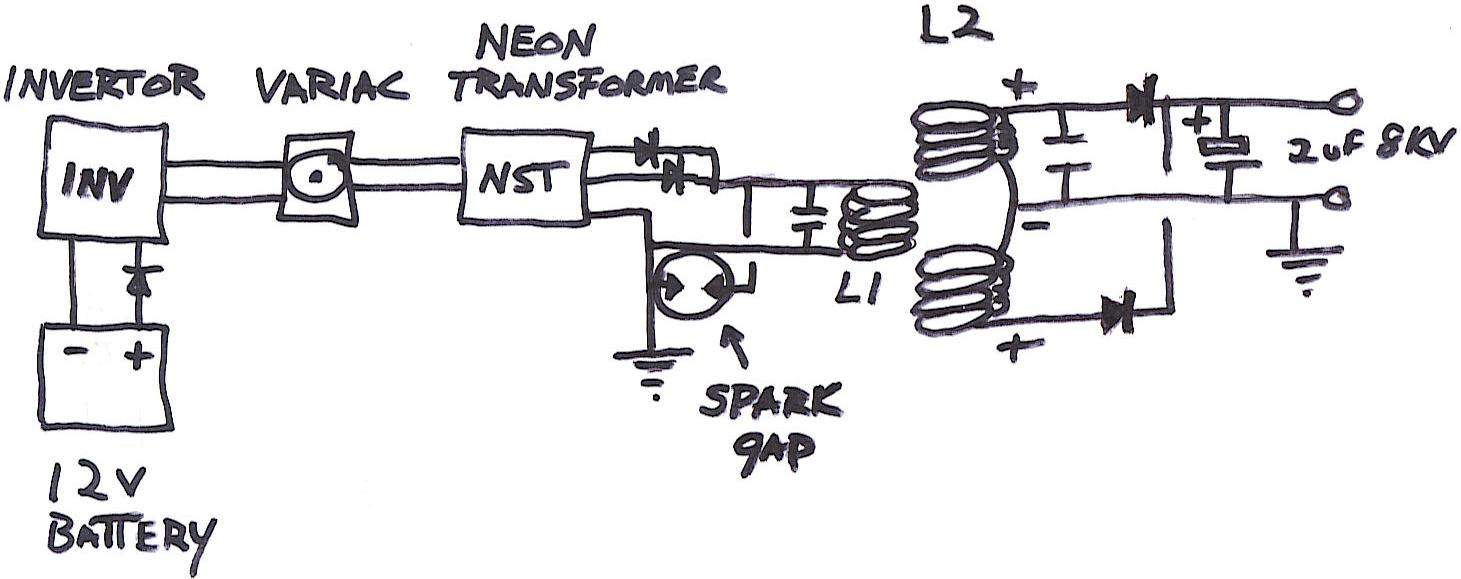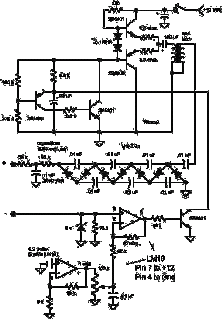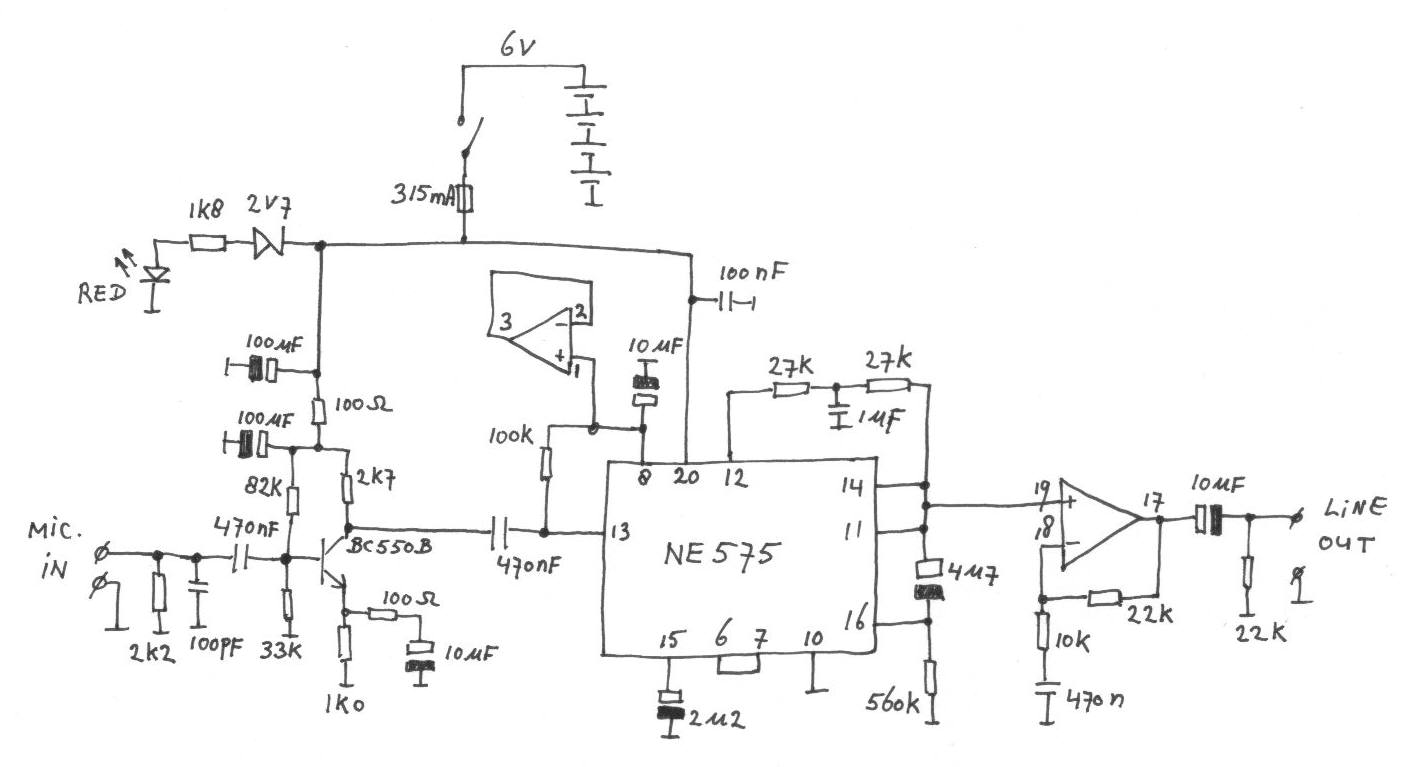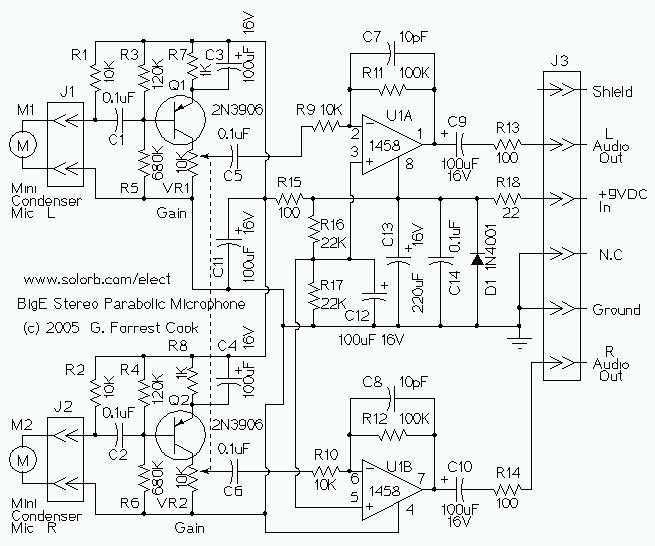
Big vacuum tube tesla coil with GU-81M
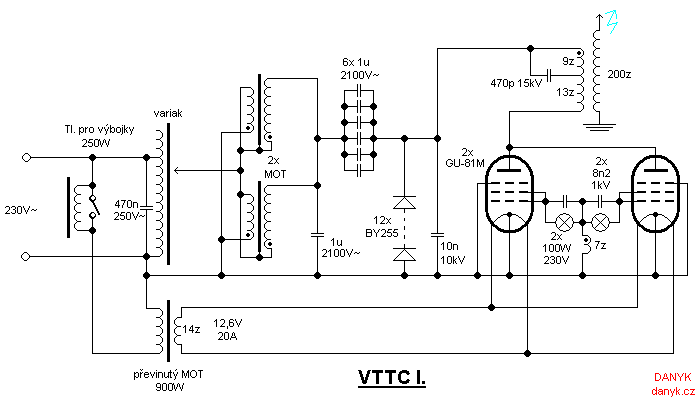
The Vacuum Tube Tesla Coil (VTTC) is a Tesla coil that utilizes vacuum tubes as switches. It features a self-oscillating circuit with two Russian GU-81M tubes connected in parallel. High voltage is sourced from two Microwave Oven Transformers (MOTs) that are also connected in parallel, with their secondary windings linked to the primary winding to slightly increase the voltage. The system is powered through a variac, although operation without it is feasible. The secondaries of the MOTs are connected to a voltage doubler using microwave oven capacitors (MOCs). A parallel-connected capacitor rated at 10nF/10kV blocks high-frequency currents. The heating voltage is supplied by a rewound MOT with 14 turns. Heating is activated in two stages: first through a ballast and subsequently directly, with the ballast being shorted via a switch. The tubes operate in triode mode, utilizing 100W/230V lamps for grid resistance. The secondary coil consists of 200 turns of 1mm diameter wire on an 11 cm diameter PVC pipe, with a winding height of 23 cm, resonating at 1.3 MHz. The primary coil has 22 turns of thick insulated wire wound on a 16 cm diameter form, featuring multiple taps to connect the resonant capacitor, which is a pulse capacitor rated at 470pF and 15kV (40kVAr). Optimal performance was achieved with a connection at 9 turns. A feedback winding of 7 turns is situated below the secondary. The device produces streamers measuring 45 cm in length. Testing also included a second secondary coil, wound in a sprawling spiral with 50 turns, resonating at 4.6 MHz. For this secondary, the best results were obtained with 9 turns on the primary and a 4-turn feedback winding, functioning without a resonant capacitor. WARNING: The Tesla coil is an extremely dangerous device. Individuals lacking knowledge of high voltage principles should not attempt construction. All components are directly connected to mains power, and MOTs generate high voltage at several amperes. The Tesla coil creates broad-spectrum radio frequency interference, which can damage electronic devices or storage media. It also produces ozone (O3) and other toxic gases, requiring proper ventilation. All actions are taken at the user's own risk, and no responsibility is accepted for any injuries. Frequency measurements (at low power, using DC) were performed with a multimeter and frequency meter, both agreeing on a frequency of 1.3 MHz. Measurements were conducted "wirelessly," with devices positioned about 1 meter from the VTTC and their inputs in the air. Capacitors salvaged from magnetrons can serve as emergency resonant capacitors, with a combined capacity of approximately 2x 400pF. One pole is formed by the skeleton, while the second pole is created by merging the two outlets.
The VTTC circuit operates on the principles of high-frequency oscillation and resonance, utilizing vacuum tubes that act as high-speed switches. The GU-81M tubes are capable of handling high voltages and currents, making them suitable for this application. The parallel configuration of the tubes enhances the output power and reliability of the system. The use of MOTs as high voltage sources allows for significant voltage amplification, which is critical for the operation of a Tesla coil.
The primary and secondary coils are designed to resonate at specific frequencies, which allows for efficient energy transfer. The primary coil's multiple taps enable fine-tuning of the resonant frequency, optimizing the performance of the coil. The feedback winding plays a crucial role in sustaining oscillations by providing the necessary feedback to the tube circuit.
Safety precautions are paramount when working with Tesla coils. The high voltages involved can be lethal, and proper insulation, grounding, and shielding should be implemented to protect the operator and surrounding equipment. Additionally, the generation of ozone and other gases necessitates adequate ventilation to ensure a safe working environment.
The design of the VTTC offers versatility, allowing for experimentation with different configurations, such as the second secondary coil. This adaptability can lead to various resonant frequencies and output characteristics, further enhancing the educational and practical applications of the device. Overall, the VTTC represents a fascinating intersection of vacuum tube technology and high-frequency electrical engineering, providing a platform for exploration in the field of electromagnetism.VTTC (Vacuum tube tesla coil) is a Tesla coil with vacuum tubes as a switch. I used self-oscillating circuit with two russian (soviet) tubes GU-81M connected in parallel. The source of high voltage are two MOTs (Microwave oven transformers) connected in parallel and with the secondary connected to the top of primary (it increases the voltage a lit tle). They are fed through a variac, but the operation without variac is also possible. MOT secondaries are connected to the doubler with microwave oven capacitors (MOCs). High-frequency current is blocked by parallel connected capacitor 10n/10kV. Heating voltage provides rewound MOT with 14 turns. Heating is switched on in two steps - first through a ballast, and then directly (the ballast is shorted with a switch). The tubes are operated in triode mode. As the grid resistance i use 100W/230V lamps. The secondary has a 200turns with of wire diameter of 1mm on a 11 cm diameter PVC (novodur) pipe. Winding height is 23cm. Resonance at 1. 3 MHz. The primary has 22 turns of thick insulated wire and wound on 16 centimeters diameter. The primary has many taps to connect the resonance capacitor (TC is tubed by switching taps). As a resonant capacitor I used the pulse capacitor 470pF 15kV 40kVAr. The best results i got with the tap at 9 turns. Feedback winding is 7 turns and is located below the secondary. Sparks (streamers) are 45 cm. I tested this VTTC also with second secondary, wound in the sprawling spiral with 50 turns and resonant frequency 4.
6 MHz. For this secondary seemed the best 9 turns on primary and feedback winding with 4 turns. It worked without a resonant capacitor. WARNING ! Tesla coil is extremely dangerous device! Without knowledge of the principles of working with high voltage, you should not construct it. All parts are connected directly to mains. MOTs produce high voltage with current of several ampers. Tesla coil is causing a broadband radio frequency interference. Electromagnetic radiation can damage electronic devices or storage media. During the operation it produces ozone (O3) and other toxic gases, must be ventilated! Everything you do at your own risk! For any injury I do not take any responsibility. Measuring the frequency (low power, DC operated, of course). Multimeter and frequency meter agree to 1. 3 MHz. Measurement is "wireless". Both devices measured about 1 meter from VTTC, with inputs in the air Capacitors salvaged from magnetron. In an emergency it can also be used as a resonant capacitor. Capacity is about 2x 400pF. One pole is the skeleton, the second pole formed by the merger of the two outlets. 🔗 External reference
The VTTC circuit operates on the principles of high-frequency oscillation and resonance, utilizing vacuum tubes that act as high-speed switches. The GU-81M tubes are capable of handling high voltages and currents, making them suitable for this application. The parallel configuration of the tubes enhances the output power and reliability of the system. The use of MOTs as high voltage sources allows for significant voltage amplification, which is critical for the operation of a Tesla coil.
The primary and secondary coils are designed to resonate at specific frequencies, which allows for efficient energy transfer. The primary coil's multiple taps enable fine-tuning of the resonant frequency, optimizing the performance of the coil. The feedback winding plays a crucial role in sustaining oscillations by providing the necessary feedback to the tube circuit.
Safety precautions are paramount when working with Tesla coils. The high voltages involved can be lethal, and proper insulation, grounding, and shielding should be implemented to protect the operator and surrounding equipment. Additionally, the generation of ozone and other gases necessitates adequate ventilation to ensure a safe working environment.
The design of the VTTC offers versatility, allowing for experimentation with different configurations, such as the second secondary coil. This adaptability can lead to various resonant frequencies and output characteristics, further enhancing the educational and practical applications of the device. Overall, the VTTC represents a fascinating intersection of vacuum tube technology and high-frequency electrical engineering, providing a platform for exploration in the field of electromagnetism.VTTC (Vacuum tube tesla coil) is a Tesla coil with vacuum tubes as a switch. I used self-oscillating circuit with two russian (soviet) tubes GU-81M connected in parallel. The source of high voltage are two MOTs (Microwave oven transformers) connected in parallel and with the secondary connected to the top of primary (it increases the voltage a lit tle). They are fed through a variac, but the operation without variac is also possible. MOT secondaries are connected to the doubler with microwave oven capacitors (MOCs). High-frequency current is blocked by parallel connected capacitor 10n/10kV. Heating voltage provides rewound MOT with 14 turns. Heating is switched on in two steps - first through a ballast, and then directly (the ballast is shorted with a switch). The tubes are operated in triode mode. As the grid resistance i use 100W/230V lamps. The secondary has a 200turns with of wire diameter of 1mm on a 11 cm diameter PVC (novodur) pipe. Winding height is 23cm. Resonance at 1. 3 MHz. The primary has 22 turns of thick insulated wire and wound on 16 centimeters diameter. The primary has many taps to connect the resonance capacitor (TC is tubed by switching taps). As a resonant capacitor I used the pulse capacitor 470pF 15kV 40kVAr. The best results i got with the tap at 9 turns. Feedback winding is 7 turns and is located below the secondary. Sparks (streamers) are 45 cm. I tested this VTTC also with second secondary, wound in the sprawling spiral with 50 turns and resonant frequency 4.
6 MHz. For this secondary seemed the best 9 turns on primary and feedback winding with 4 turns. It worked without a resonant capacitor. WARNING ! Tesla coil is extremely dangerous device! Without knowledge of the principles of working with high voltage, you should not construct it. All parts are connected directly to mains. MOTs produce high voltage with current of several ampers. Tesla coil is causing a broadband radio frequency interference. Electromagnetic radiation can damage electronic devices or storage media. During the operation it produces ozone (O3) and other toxic gases, must be ventilated! Everything you do at your own risk! For any injury I do not take any responsibility. Measuring the frequency (low power, DC operated, of course). Multimeter and frequency meter agree to 1. 3 MHz. Measurement is "wireless". Both devices measured about 1 meter from VTTC, with inputs in the air Capacitors salvaged from magnetron. In an emergency it can also be used as a resonant capacitor. Capacity is about 2x 400pF. One pole is the skeleton, the second pole formed by the merger of the two outlets. 🔗 External reference
Warning: include(partials/cookie-banner.php): Failed to open stream: Permission denied in /var/www/html/nextgr/view-circuit.php on line 713
Warning: include(): Failed opening 'partials/cookie-banner.php' for inclusion (include_path='.:/usr/share/php') in /var/www/html/nextgr/view-circuit.php on line 713
